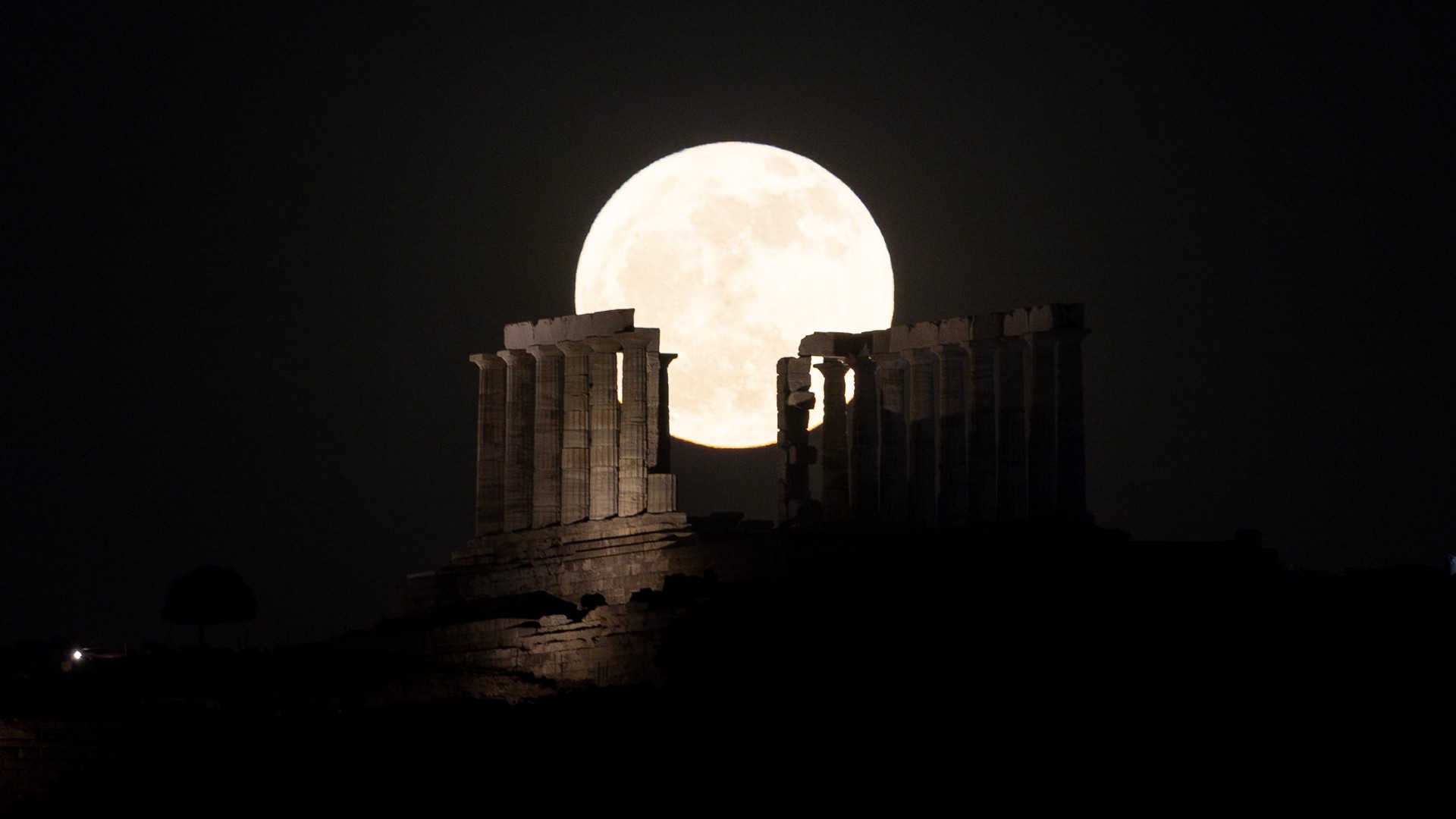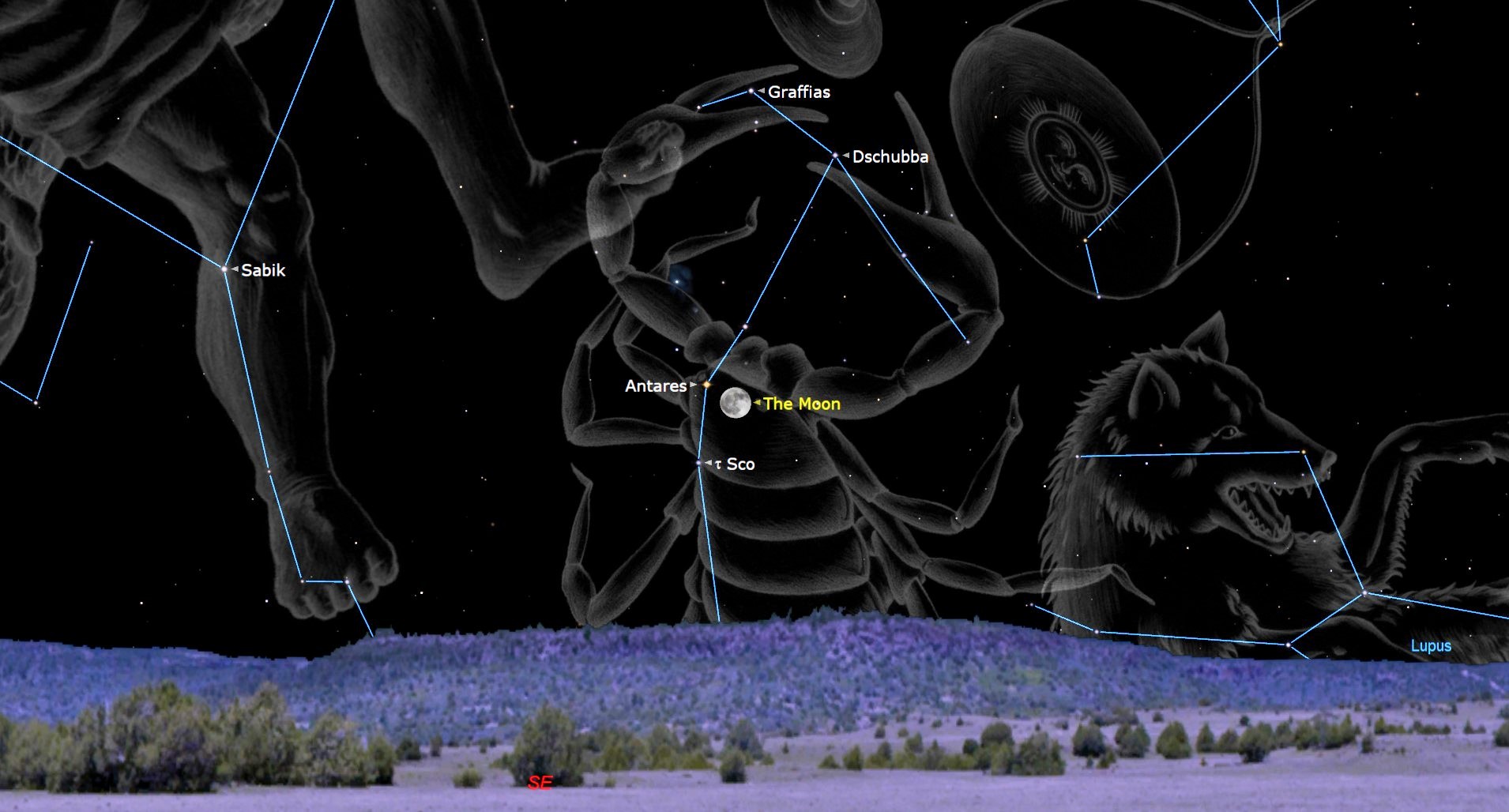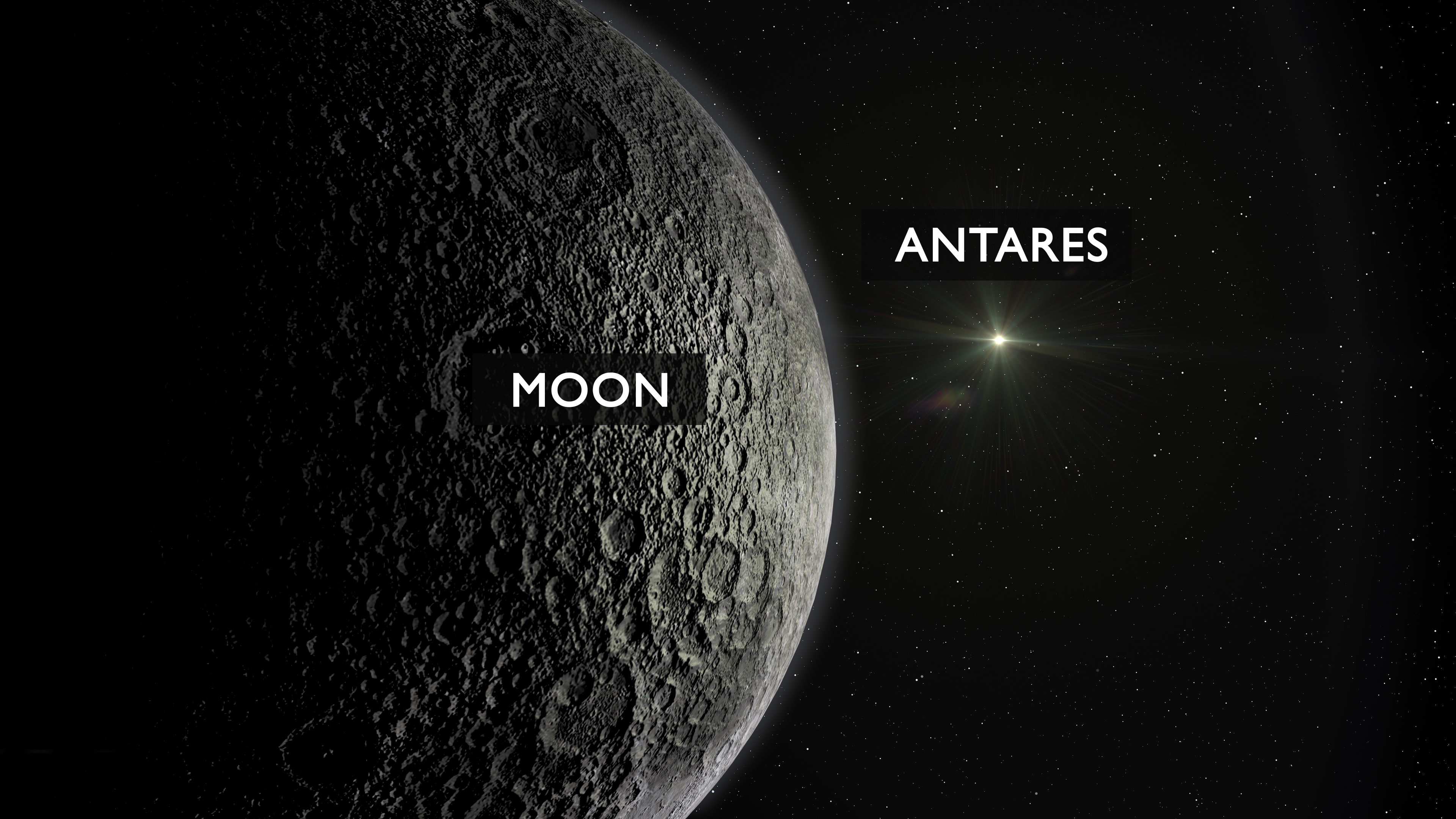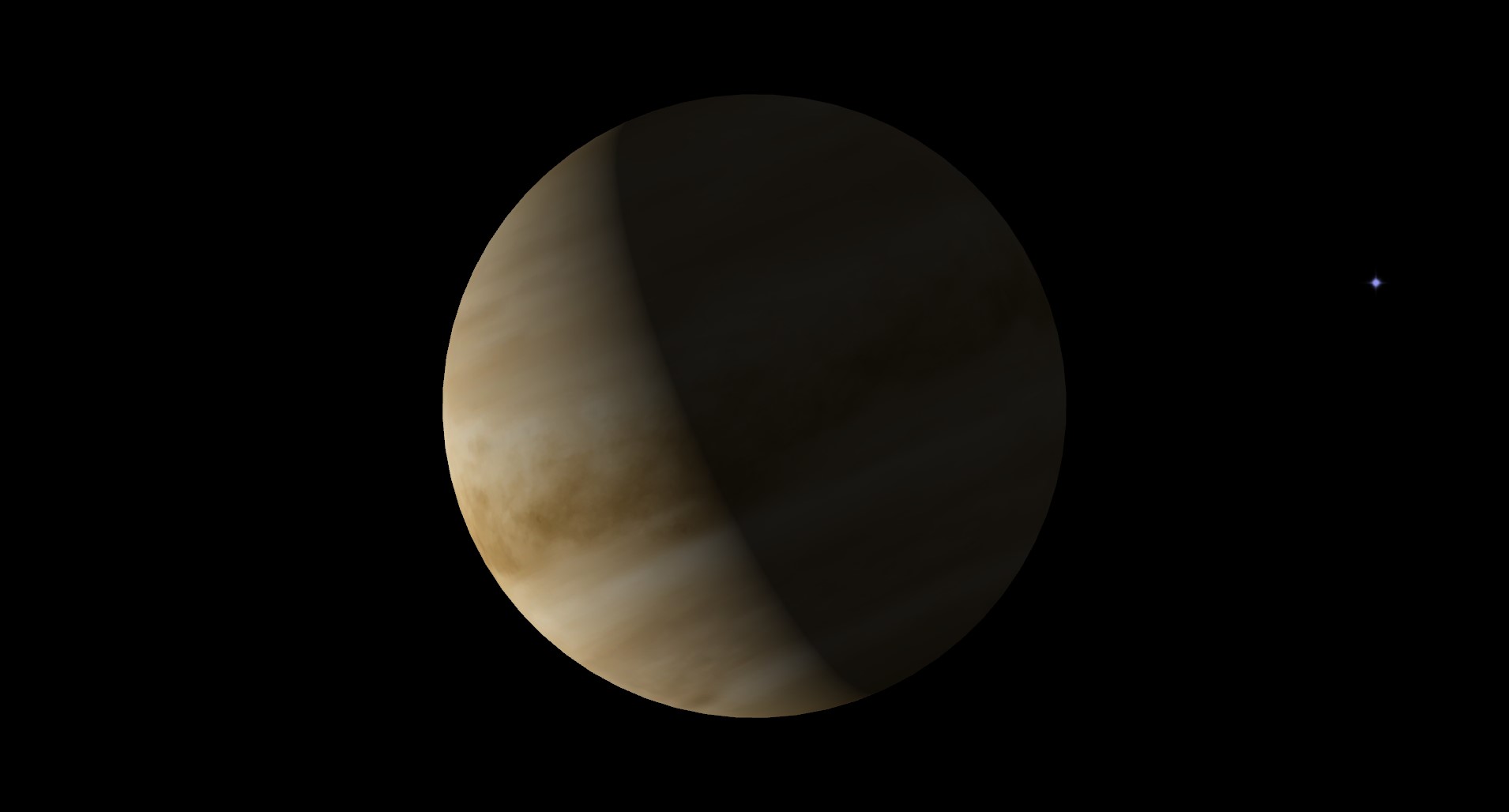
The full moon of May, called the Flower Moon, will occur in the eastern U.S. during the evening hours of May 12. Two days later, the just-past-full moon will occult the star Antares.
Moons are full when they are on the opposite side of Earth from the sun, and fully illuminated (from the point of view of Earth). They happen every 29.5 days, but this is actually slightly longer than the time it takes the moon to complete one revolution around our planet, which is 27.3 days. The reason is the movement of Earth around the sun; in the time it takes the moon to circle around Earth, our planet has moved a short distance along its orbit (a bit less than one twelfth of the way), so the moon has to go a little further to get to the opposite side of Earth from the sun.
The exact moment of full moon occurs at 12:55 p.m. Eastern Time (1656 UTC) on May 12, according to the U.S. Naval Observatory. In New York City, the moon will rise at 8:30 p.m. Eastern Daylight Time. Sunset that day is at 8:03 p.m. The moon will be in the constellation Libra.

Looking for a telescope to see the moon? We recommend the Celestron Astro Fi 102 as the top pick in our best beginner's telescope guide.
The rising time of the moon depends on one's latitude; as one moves south the moon rises earlier; in Miami, moonrise is at 8:15 p.m. with sunset at 7:58 p.m. In Honolulu, where the full moon occurs at 6:56 a.m., moonrise is at 7:28 p.m. with sunset at 7:01 p.m. This happens because like the sun, the moon is at differing altitudes in the sky depending on the time of year. The path the sun traces out against the background stars is called the ecliptic, and in summertime, due to the tilt of Earth's axis, the point on that path the sun is on appears higher in the sky.
The moon also traces out a path along the ecliptic, (though it is slightly "off" because the moon's orbit is inclined five degrees to the ecliptic plane). Since a full moon puts sun and moon on opposite points of the ecliptic, the moon will be on the one that is lower in the sky during the spring and summer months. For Northern Hemisphere observers the time the full moon is above the horizon will thus be shorter in the summer and longer in the winter. (The same pattern holds true in the Southern Hemisphere, but the months are "reversed" as their summer is in December rather than June).
Two days after the full moon, on May 14, the moon will pass in front of the star Antares, the brightest star in Scorpius, the Scorpion. The occultation will be visible in the southern half of South America; the rest of the world will see a close approach – from North America, Europe or Asia the moon will appear to pass just to the south (below) Antares; the two reach conjunction (sharing the same celestial longitude) at 0452 UTC, or 12:52 a.m. Eastern.
For those who can see the occultation, how long Antares disappears behind the moon depends on one's location. For example, in Buenos Aires, the occultation starts at 1:06 a.m. (0406 UTC), according to LunarOccultations.com. The moon will be almost directly overhead (the actual altitude will be 77 degrees and it will be slightly to the east of north). Antares will reappear at 2:13 a.m. local time (0513 UTC) for a total time behind the moon of 67 minutes.

In Santiago, Chile, the occultation starts on May 13, at 11:32 p.m. local time (0332 UTC) and ends at 12:49 a.m. May 14 (0449 UTC), for 77 minutes of occultation. From Santiago the moon will be slightly lower in the sky, at an altitude of about 60 degrees in the northeast. In Pelotas, Brazil, which is near the northern limit of visibility, Antares disappears at 1:46 a.m. May 14 and reappears at 2:01 a.m. – just 15 minutes later. As in Buenos Aires, the moon will be almost directly overhead – at 83 degrees above the northwestern horizon – when the occultation starts.

You can prepare for the next full moon or eclipse with our guide on how to photograph a lunar eclipse, as well as how to photograph the moon with a camera in general, can help you make the most of the event. If you need imaging gear, consider our best cameras for astrophotography and best lenses for astrophotography to make sure you're ready for the next eclipse.
If you're looking for binoculars or a telescope to observe the moon, check out our guides for the best binoculars and best telescopes.
Related: The ultimate guide to observing the moon
Visible planets
Outside of the occultation zone, mid-May still offers visible planets. In mid-northern latitudes, on the evening of May 12, Jupiter will be in the west as the moon rises, and Mars in the southwest. From New York City, Jupiter is about 21 degrees high at moonrise (about 8:30 p.m.); it will be one of the "stars" one sees against the slightly lighter part of the evening sky. Mars will be about 56 degrees high, though it may take another fifteen minutes to half an hour to become really distinct. New York City observers will see Jupiter set at 10:34 p.m., according to the U.S. Naval Observatory, while Mars sets at 1:41 a.m. on May 13.
The next planet to grace the sky is Saturn, which rises in New York City at 3:35 a.m. on May 13. Venus follows at 3:50 a.m. Sunrise is at 5:40 a.m. and Venus will stay visible until at least 5 a.m.; depending on the weather and the clarity of the sky near one's local horizon, it can even remain visible after the start of civil dawn (5:09 a.m.), when the sun is 6 degrees below the horizon and Venus is 14.5 degrees high.

As one moves southwards, the planets gain altitude. In Miami, moonrise is at 8:15 p.m. (sunset is at 7:58 p.m.) and Jupiter is at just under 26 degrees high in the west; it sets at 10:20 p.m. Mars is at 69 degrees in the southwest and sets at 1:35 a.m. on May 13. Saturn rises at 3:57 a.m. on May 13, Venus at 4:20 a.m., while sunrise is at 6:36 a.m. – Venus will be a full 24 degrees above the horizon at the start of civil twilight (6:11 a.m. local time).
In Quito (or other equatorial locations such as Singapore), Jupiter sets at 8:25 on May 12. Moonrise there is at 6:22 p.m.; at that point the sky will still be a little bit light as sunset is at 6:07 p.m. By 7 p.m. when it gets darker, Jupiter will be 18 degrees high and almost due west. At that point, Mars will be 63 degrees high in the northwest; the Red Planet sets in Quito at 11:49 p.m. on May 12.
Saturn appears at 2:46 a.m. on May 13; notably earlier than in locations further north, as the angle it makes with the horizon is much steeper. In addition, sunrise is later than in more northerly regions, meaning the ringed planet stays visible longer. Venus rises at 3:19 a.m. local time. By 5:30 a.m. Venus is 32 degrees high in the east, with Saturn above and to the right at 40 degrees.
From locations at the equator, it is just possible (if challenging) to see Mercury; from Quito, the planet is just under 7 degrees above the eastern horizon by 5:30 a.m.; it rises at 5:00 a.m. on May 13.
In the Southern Hemisphere mid-latitudes, the nights are getting longer; in Buenos Aires the sun sets on May 12 at 6:01 p.m. local time and moonrise is at 5:44 p.m. In contrast with Northern Hemisphere or equatorial locales, by 7 p.m., when the sky is fully dark, observers will see Jupiter and Mars lower in the sky. Jupiter will be in the west, only 9 degrees high; the planet sets at 7:58 p.m. Mars will be in the north-northwest, about 36 degrees in altitude; Mars sets by 11:35 p.m.
Saturn rises at 3:19 a.m. on May 13 in Buenos Aires; Venus at 4:05 a.m. By 6:30 a.m. Venus and Saturn will be in an almost vertical line with Saturn at the top, 38 degrees above the east-northeastern horizon; Venus will be 10 degrees (about the span of two fists at arm's length) below it. Sunrise in Buenos Aires is at 7:38 a.m. on May 13.
Constellations
In the mid-May sky, for Northern Hemisphere observers, the winter constellations, Orion, Taurus, Gemini, and Canis Major are all setting by 9 p.m. and giving way to the spring and summer stars. From the latitude of New York City, Chicago, or Denver one can face south, look almost straight up and see Leo the Lion. To find it look for Mars (which is also quite high and recognizably reddish) and go to the left (eastwards). One will see a distinct "sickle" shape with Regulus, Leo's brightest star, at the bottom of the handle. This is the mane (the curved part) and the front paws (Regulus) of the Lion.
Look to the left of Regulus (in a straight line across) and one will encounter first a faintish star, then a brighter one. The fainter one is Chertan, or Al-Haratan, and the brighter one is Denebola. Denebola is the end of the Lion's tail; Al-Haratan would be the rear paws. Above those two stars, forming a right triangle, is Zosma, which is the Lion's rump.
Draw a line from Zosma to Denebola and you reach Virgo, one can recognize her by the presence of Spica, the blue-white star that is the brightest in that constellation. If one's observing site isn't too light-polluted and one looks to the right of Spica, one can sometimes see a faint group of four stars forming a small crooked box shape; this is Corvus, the Crow. Just west (to the right) of Corvus is a faint line of stars that runs westwards; start at the right of Corvus with what is the first noticeable star; this is Delta Crateris, one of the brighter stars in Crater, the Cup. Go a bit more to the right and the line of three stars make up the end of the Hydra. Both constellations are relatively faint.
Looking north, one can see the Big Dipper, which will be high in the northeast with the "bowl" nearly upside down. One can use the famous "pointers' at the front (called Dubhe and Merak) to find Polaris, the Pole Star. But in the other direction, one can "Arc to Arcturus"– Arcturus being the brightest star in Boötes, the Herdsman, which will be high in the east. Just below Boötes, one can see a curved line of stars that is Corona Borealis, the Northern Crown, whose brightest star is Alphecca. Go a little further towards the horizon and one sees a quadrangle of stars that is Hercules.
In the Southern Hemisphere at the latitudes of Buenos Aires or Santiago, Chile, the sky is well dark by 7 p.m. and by 9 p.m. the autumn stars are in full swing. Rigil Kentaurus and Hadar, the two brightest stars in the Centaur, will be 50 and 54 degrees high in the southeast (from mid-southern latitudes bot are nearly circumpolar). The Southern Cross will be above those two stars, with the long spar of the cross facing down and to the right, towards the Southern Celestial Pole. If one uses the short bar of the Cross as a pointer, and goes to the right (westward) one will see a large circle of eight stars (in some places with city lights the eighth might be hard to see) which is Vela, the sail of the legendary ship of Jason, the Argo. Below that, to the right at about 31 degrees high in the southwest, is Canopus, the brightest star in Carina, the Keel of the Argo.
Looking northwards, one can see Orion moving towards the northwestern horizon; Betelgeuse is about 33 degrees high. At about the same altitude to the left one sees Rigel, and directly above Rigel at about 60 degrees is Sirius, and if one turns to the left (towards the south) one encounters Canopus, the alpha star of Carina the Keel. Looking downward again towards the southwestern horizon, another bright star, Achernar, the end of Eridanus the River, 20 degrees high.
Full moon lore
The full moon of May is often called a Flower Moon, and the term comes from the blooms that appear in North America and Europe around that time. For English-speaking Americans, the name likely also comes from people such as the Ojibwe, according to the Ontario Native Literacy Coalition. Other native peoples of the Americas had very different ideas; the Haida, for example, who live in the Pacific Northwest, would have called the May moon cycle Tahálaa Kungáay, the Food Gathering Moon. Among the Cherokee, the "Flower Moon" actually corresponded with April; May would be called the "Planting Moon."
In the traditional Chinese lunar calendar, the May full moon is in the fourth month, called Huáiyuè, the Locust Tree Month.
In much of Buddhist Southeast Asia the full moon of May is celebrated as Buddha's birthday; it is a major festival in countries such as Laos, Myanmar, Vietnam, Thailand and Cambodia.
For some observant Jews, the full moon of May is the "Second Passover," or the 14th day of the month of Iyar. It was instituted as a way of giving people who could not make Passover offerings at the Temple, usually because they became ritually impure through contact with a dead body or were traveling. Symbolically, it shows there is always an opportunity to correct past failings.
Editor's Note: If you snap an image of the full Flower Moon and would like to share it with Space.com's readers, send your photo(s), comments, and your name and location to spacephotos@space.com.







